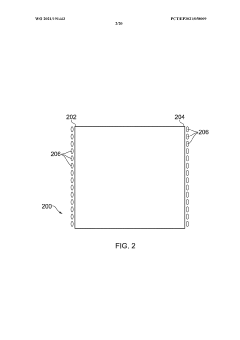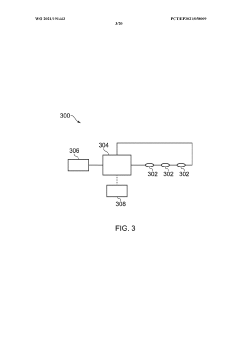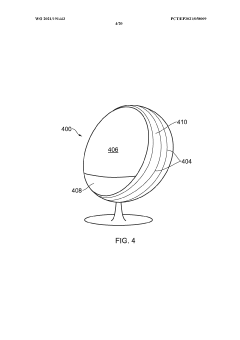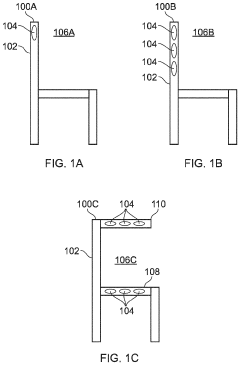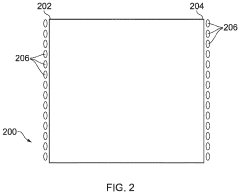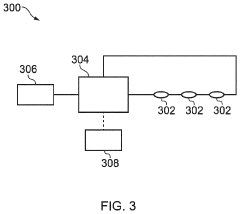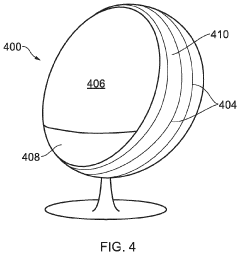Understanding Schumann Resonance: Evolution and Applications
JUN 24, 20259 MIN READ
Generate Your Research Report Instantly with AI Agent
Patsnap Eureka helps you evaluate technical feasibility & market potential.
Schumann Resonance Background and Objectives
Schumann resonances, discovered by physicist Winfried Otto Schumann in 1952, are a set of spectrum peaks in the extremely low frequency (ELF) portion of the Earth's electromagnetic field spectrum. These resonances occur between the Earth's surface and the ionosphere, creating a natural electromagnetic cavity. The fundamental frequency of Schumann resonances is approximately 7.83 Hz, with harmonics at higher frequencies.
The study of Schumann resonances has evolved significantly since their initial discovery. Initially, they were primarily of interest to atmospheric scientists and geophysicists. However, as our understanding of these resonances has grown, so too has their potential for various applications across different fields.
The primary objective in researching Schumann resonances is to gain a deeper understanding of the Earth's electromagnetic environment and its interactions with various natural and artificial phenomena. This includes investigating how these resonances are affected by solar activity, lightning storms, and changes in the ionosphere.
One key area of interest is the potential use of Schumann resonances as a global indicator of climate change. As the Earth's temperature and atmospheric composition change, these factors may influence the characteristics of Schumann resonances, potentially providing a new tool for monitoring global climate trends.
In the field of telecommunications, understanding Schumann resonances is crucial for developing more efficient and reliable long-distance communication systems. The ELF band, where these resonances occur, has unique propagation characteristics that could be exploited for global communication, particularly in situations where traditional methods are ineffective.
Medical research has also shown interest in Schumann resonances, with some studies suggesting a potential link between these frequencies and human health. While this area remains controversial, it has sparked investigations into the possible biological effects of extremely low-frequency electromagnetic fields.
The evolution of technology has greatly enhanced our ability to detect and analyze Schumann resonances. Advanced sensors and data processing techniques now allow for more precise measurements and deeper insights into the behavior of these resonances under various conditions.
Looking forward, the objectives in Schumann resonance research include developing more accurate models of the Earth-ionosphere cavity, improving our ability to predict and interpret changes in the resonances, and exploring novel applications in fields ranging from geophysics to bioelectromagnetics. As our understanding grows, so too does the potential for Schumann resonances to contribute to our knowledge of the Earth's electromagnetic environment and its far-reaching implications.
The study of Schumann resonances has evolved significantly since their initial discovery. Initially, they were primarily of interest to atmospheric scientists and geophysicists. However, as our understanding of these resonances has grown, so too has their potential for various applications across different fields.
The primary objective in researching Schumann resonances is to gain a deeper understanding of the Earth's electromagnetic environment and its interactions with various natural and artificial phenomena. This includes investigating how these resonances are affected by solar activity, lightning storms, and changes in the ionosphere.
One key area of interest is the potential use of Schumann resonances as a global indicator of climate change. As the Earth's temperature and atmospheric composition change, these factors may influence the characteristics of Schumann resonances, potentially providing a new tool for monitoring global climate trends.
In the field of telecommunications, understanding Schumann resonances is crucial for developing more efficient and reliable long-distance communication systems. The ELF band, where these resonances occur, has unique propagation characteristics that could be exploited for global communication, particularly in situations where traditional methods are ineffective.
Medical research has also shown interest in Schumann resonances, with some studies suggesting a potential link between these frequencies and human health. While this area remains controversial, it has sparked investigations into the possible biological effects of extremely low-frequency electromagnetic fields.
The evolution of technology has greatly enhanced our ability to detect and analyze Schumann resonances. Advanced sensors and data processing techniques now allow for more precise measurements and deeper insights into the behavior of these resonances under various conditions.
Looking forward, the objectives in Schumann resonance research include developing more accurate models of the Earth-ionosphere cavity, improving our ability to predict and interpret changes in the resonances, and exploring novel applications in fields ranging from geophysics to bioelectromagnetics. As our understanding grows, so too does the potential for Schumann resonances to contribute to our knowledge of the Earth's electromagnetic environment and its far-reaching implications.
Market Analysis for Schumann Resonance Applications
The market for Schumann Resonance applications has been steadily growing, driven by increasing awareness of its potential benefits and advancements in related technologies. Initially discovered in the 1950s, Schumann Resonance has gained traction in various sectors, including health and wellness, environmental monitoring, and telecommunications.
In the health and wellness industry, there is a growing demand for products that claim to harness the benefits of Schumann Resonance. These include devices designed to generate or amplify the 7.83 Hz frequency, which some believe can improve sleep quality, reduce stress, and enhance overall well-being. The global wellness market, valued at $4.5 trillion in 2018, continues to expand, providing ample opportunities for Schumann Resonance-based products.
Environmental monitoring represents another significant market segment. Schumann Resonance measurements are used to study global lightning activity, climate change, and ionospheric conditions. As concerns about climate change intensify, the demand for sophisticated monitoring tools, including those utilizing Schumann Resonance, is expected to increase.
In the telecommunications sector, Schumann Resonance has potential applications in long-range communication systems. The unique properties of extremely low frequency (ELF) waves associated with Schumann Resonance make them suitable for communication with submarines and in underground environments. This niche market is primarily driven by military and scientific research needs.
The market for Schumann Resonance applications is characterized by a mix of established companies and innovative startups. Established scientific instrument manufacturers provide high-end equipment for research and environmental monitoring. Meanwhile, wellness-focused startups are introducing consumer-grade devices, contributing to market diversification.
Geographically, North America and Europe currently lead in terms of market share, primarily due to higher awareness and research activities. However, the Asia-Pacific region is expected to show the fastest growth, driven by increasing adoption of wellness technologies and environmental monitoring initiatives.
Despite the growing interest, the market faces challenges. The lack of conclusive scientific evidence supporting some claimed benefits of Schumann Resonance in health applications has led to skepticism among some consumers and regulators. Additionally, the complexity of accurately measuring and reproducing Schumann Resonance frequencies poses technical challenges for product development.
Looking ahead, the market for Schumann Resonance applications is projected to expand as research continues to uncover potential benefits and applications. Advancements in sensor technology and data analytics are expected to drive innovation in this field, potentially opening up new market opportunities in areas such as precision agriculture, natural disaster prediction, and space weather monitoring.
In the health and wellness industry, there is a growing demand for products that claim to harness the benefits of Schumann Resonance. These include devices designed to generate or amplify the 7.83 Hz frequency, which some believe can improve sleep quality, reduce stress, and enhance overall well-being. The global wellness market, valued at $4.5 trillion in 2018, continues to expand, providing ample opportunities for Schumann Resonance-based products.
Environmental monitoring represents another significant market segment. Schumann Resonance measurements are used to study global lightning activity, climate change, and ionospheric conditions. As concerns about climate change intensify, the demand for sophisticated monitoring tools, including those utilizing Schumann Resonance, is expected to increase.
In the telecommunications sector, Schumann Resonance has potential applications in long-range communication systems. The unique properties of extremely low frequency (ELF) waves associated with Schumann Resonance make them suitable for communication with submarines and in underground environments. This niche market is primarily driven by military and scientific research needs.
The market for Schumann Resonance applications is characterized by a mix of established companies and innovative startups. Established scientific instrument manufacturers provide high-end equipment for research and environmental monitoring. Meanwhile, wellness-focused startups are introducing consumer-grade devices, contributing to market diversification.
Geographically, North America and Europe currently lead in terms of market share, primarily due to higher awareness and research activities. However, the Asia-Pacific region is expected to show the fastest growth, driven by increasing adoption of wellness technologies and environmental monitoring initiatives.
Despite the growing interest, the market faces challenges. The lack of conclusive scientific evidence supporting some claimed benefits of Schumann Resonance in health applications has led to skepticism among some consumers and regulators. Additionally, the complexity of accurately measuring and reproducing Schumann Resonance frequencies poses technical challenges for product development.
Looking ahead, the market for Schumann Resonance applications is projected to expand as research continues to uncover potential benefits and applications. Advancements in sensor technology and data analytics are expected to drive innovation in this field, potentially opening up new market opportunities in areas such as precision agriculture, natural disaster prediction, and space weather monitoring.
Current State and Challenges in Schumann Resonance Research
Schumann resonance research has made significant strides in recent years, yet it continues to face several challenges. The current state of this field is characterized by a blend of established knowledge and emerging questions.
One of the primary advancements has been the improvement in detection and measurement techniques. High-sensitivity magnetometers and advanced signal processing algorithms have enhanced our ability to isolate Schumann resonance signals from background noise. This has led to more accurate measurements of resonance frequencies and their variations.
However, a major challenge remains in understanding the complex interactions between the Earth's ionosphere, magnetosphere, and the global lightning activity that drives Schumann resonances. The dynamic nature of these systems makes it difficult to create comprehensive models that can accurately predict resonance behavior under all conditions.
Another area of progress is the growing body of data on long-term variations in Schumann resonances. Researchers have observed correlations between these variations and various geophysical phenomena, including solar activity, climate changes, and even seismic events. Yet, interpreting these correlations and establishing causal relationships remains a significant challenge.
The global network of Schumann resonance monitoring stations has expanded, providing better coverage and more diverse data sets. This has improved our understanding of regional differences in resonance characteristics. However, maintaining consistent data quality across different stations and integrating these diverse data sets pose ongoing challenges.
In terms of applications, Schumann resonances are increasingly being explored as potential tools for monitoring global lightning activity, studying ionospheric dynamics, and even as indicators of global temperature changes. However, translating these potential applications into reliable, practical tools is still a work in progress.
A particularly intriguing area of current research is the investigation of potential biological effects of Schumann resonances. While some studies suggest possible influences on human physiology and behavior, this remains a controversial topic with significant challenges in experimental design and data interpretation.
Technological limitations also persist, particularly in developing portable, low-cost monitoring equipment that can maintain the necessary sensitivity and accuracy. This challenge is crucial for expanding the global monitoring network and making Schumann resonance research more accessible to a broader scientific community.
One of the primary advancements has been the improvement in detection and measurement techniques. High-sensitivity magnetometers and advanced signal processing algorithms have enhanced our ability to isolate Schumann resonance signals from background noise. This has led to more accurate measurements of resonance frequencies and their variations.
However, a major challenge remains in understanding the complex interactions between the Earth's ionosphere, magnetosphere, and the global lightning activity that drives Schumann resonances. The dynamic nature of these systems makes it difficult to create comprehensive models that can accurately predict resonance behavior under all conditions.
Another area of progress is the growing body of data on long-term variations in Schumann resonances. Researchers have observed correlations between these variations and various geophysical phenomena, including solar activity, climate changes, and even seismic events. Yet, interpreting these correlations and establishing causal relationships remains a significant challenge.
The global network of Schumann resonance monitoring stations has expanded, providing better coverage and more diverse data sets. This has improved our understanding of regional differences in resonance characteristics. However, maintaining consistent data quality across different stations and integrating these diverse data sets pose ongoing challenges.
In terms of applications, Schumann resonances are increasingly being explored as potential tools for monitoring global lightning activity, studying ionospheric dynamics, and even as indicators of global temperature changes. However, translating these potential applications into reliable, practical tools is still a work in progress.
A particularly intriguing area of current research is the investigation of potential biological effects of Schumann resonances. While some studies suggest possible influences on human physiology and behavior, this remains a controversial topic with significant challenges in experimental design and data interpretation.
Technological limitations also persist, particularly in developing portable, low-cost monitoring equipment that can maintain the necessary sensitivity and accuracy. This challenge is crucial for expanding the global monitoring network and making Schumann resonance research more accessible to a broader scientific community.
Existing Measurement and Analysis Techniques
01 Schumann resonance devices for health and wellness
Various devices are designed to generate or utilize Schumann resonance frequencies for potential health benefits. These devices aim to simulate the natural electromagnetic frequencies of the Earth to promote relaxation, improve sleep quality, and enhance overall well-being. Some implementations include wearable devices, room-based generators, and portable units that emit Schumann resonance frequencies.- Schumann resonance measurement devices: Various devices have been developed to measure and analyze Schumann resonances. These devices typically include sensors, amplifiers, and signal processing units to detect and record the low-frequency electromagnetic waves associated with Schumann resonances. Some designs incorporate portable or wearable features for ease of use in different environments.
- Therapeutic applications of Schumann resonances: Schumann resonances have been explored for potential therapeutic applications. Devices and methods have been developed to generate or simulate these resonances for health and wellness purposes. These applications often involve exposure to low-frequency electromagnetic fields that mimic natural Schumann resonances, with the aim of promoting relaxation, improving sleep quality, or enhancing overall well-being.
- Integration of Schumann resonances in electronic devices: Efforts have been made to incorporate Schumann resonance technology into various electronic devices and appliances. This integration aims to create products that can generate or utilize Schumann resonances for potential health benefits or improved functionality. Examples include air purifiers, sleep aids, and personal wellness devices that incorporate Schumann resonance generators or sensors.
- Environmental monitoring using Schumann resonances: Schumann resonances have been utilized in environmental monitoring applications. Systems and methods have been developed to analyze changes in Schumann resonance patterns to detect or predict various environmental phenomena, such as seismic activity, atmospheric conditions, or electromagnetic disturbances. These applications often involve sophisticated signal processing and data analysis techniques.
- Schumann resonance shielding and protection: Technologies have been developed to shield or protect sensitive equipment and living spaces from electromagnetic interference, including Schumann resonances. These solutions may involve specialized materials, structures, or devices designed to attenuate or block low-frequency electromagnetic fields while maintaining a balance with beneficial natural frequencies.
02 Schumann resonance in environmental monitoring and research
Schumann resonance is utilized in environmental monitoring and research applications. Devices and systems are developed to measure and analyze these resonances for studying global lightning activity, climate change, and ionospheric conditions. These technologies may include sensitive antennas, signal processing equipment, and data analysis software to detect and interpret Schumann resonance signals.Expand Specific Solutions03 Integration of Schumann resonance in meditation and relaxation products
Schumann resonance frequencies are incorporated into various meditation and relaxation products. These may include specialized audio devices, meditation cushions, or relaxation pods that generate or amplify Schumann resonance frequencies. The aim is to create an environment that mimics the Earth's natural electromagnetic field to enhance meditation practices and promote relaxation.Expand Specific Solutions04 Schumann resonance in electromagnetic shielding and protection
Technologies are developed to incorporate Schumann resonance principles in electromagnetic shielding and protection devices. These innovations aim to protect individuals from harmful electromagnetic radiation while maintaining exposure to beneficial Schumann resonance frequencies. Applications may include protective clothing, room shielding systems, or personal devices that selectively filter electromagnetic frequencies.Expand Specific Solutions05 Schumann resonance applications in agriculture and plant growth
Schumann resonance technologies are applied in agricultural settings to potentially enhance plant growth and crop yields. Devices and systems are designed to generate or amplify Schumann resonance frequencies in greenhouses, hydroponic setups, or open fields. These applications aim to simulate natural electromagnetic conditions that may benefit plant development and overall agricultural productivity.Expand Specific Solutions
Key Players in Schumann Resonance Research and Applications
The field of Schumann Resonance research is in a mature stage, with ongoing applications and developments. The market size is relatively niche but growing, driven by increasing interest in Earth-ionosphere cavity monitoring and potential health applications. Technologically, it's well-established, with companies like Koninklijke Philips NV and Siemens Healthcare GmbH applying it in various sectors. Universities such as Yale and Rochester are advancing the fundamental research, while corporations like Intel Corp. and Infineon Technologies AG are exploring its potential in electronics and communications. The involvement of diverse players, from research institutions to major tech companies, indicates a competitive landscape with opportunities for both scientific advancement and commercial applications.
Fraunhofer-Gesellschaft eV
Technical Solution: Fraunhofer-Gesellschaft has developed advanced sensor systems for detecting and analyzing Schumann resonances. Their technology utilizes highly sensitive magnetometers and sophisticated signal processing algorithms to isolate and measure the weak electromagnetic signals associated with Schumann resonances. The system incorporates real-time data analysis capabilities, allowing for continuous monitoring of global electromagnetic activity. Fraunhofer's approach also includes the integration of machine learning techniques to improve signal detection and interpretation, enhancing the overall accuracy and reliability of Schumann resonance measurements.
Strengths: Cutting-edge sensor technology, advanced signal processing, and integration of AI for improved accuracy. Weaknesses: Potentially high cost and complexity, may require specialized expertise for operation and maintenance.
Intel Corp.
Technical Solution: Intel has developed a specialized chip architecture optimized for processing Schumann resonance data. This system-on-chip (SoC) solution integrates high-performance analog-to-digital converters with powerful digital signal processing cores, enabling real-time analysis of electromagnetic signals in the ELF (Extremely Low Frequency) range. The chip incorporates noise reduction techniques and adaptive filtering algorithms to enhance the detection of weak Schumann resonance signals. Intel's solution also features low-power operation modes, making it suitable for deployment in remote monitoring stations and portable devices for field research.
Strengths: High integration, energy efficiency, and specialized processing capabilities. Weaknesses: May have limited flexibility for other applications, potential for high initial development costs.
Core Innovations in Schumann Resonance Detection
A magnetic field exposure system and uses thereof
PatentWO2021191443A1
Innovation
- A magnetic field exposure system generating an amplitude-modulated low frequency magnetic field with a carrier frequency of 360 to 450 Hz and a modulation frequency of 0.5 to 100 Hz, with a field strength of 0.5 to 250 mT, specifically designed to expose organic cells or tissues to improve cell survival, proliferation, reduce stress, and enhance well-being.
A magnetic field exposure system and uses thereof
PatentPendingUS20230372726A1
Innovation
- A magnetic field exposure system generating an amplitude-modulated low frequency magnetic field with a carrier frequency of 360 to 450 Hz and a modulation frequency of 0.5 to 100 Hz, providing a field strength of 0.5 to 250 μT, specifically designed to enhance cell survival, proliferation, reduce stress, and promote tissue regeneration.
Environmental Factors Affecting Schumann Resonance
The Schumann resonance, a set of spectral peaks in the Earth's electromagnetic field spectrum, is significantly influenced by various environmental factors. These factors play a crucial role in shaping the characteristics and behavior of the resonance, affecting its frequency, amplitude, and overall stability.
One of the primary environmental factors impacting Schumann resonance is global lightning activity. As lightning strikes are the main excitation source for these resonances, variations in global thunderstorm patterns directly affect the resonance's intensity and frequency. Seasonal changes in lightning activity, particularly in tropical regions, lead to observable fluctuations in Schumann resonance parameters.
Solar activity also plays a significant role in modulating Schumann resonance. Solar flares and coronal mass ejections can cause disturbances in the Earth's ionosphere, altering its conductivity and height. These changes in the ionospheric conditions directly impact the propagation of electromagnetic waves within the Earth-ionosphere cavity, thereby affecting the Schumann resonance characteristics.
Geomagnetic storms, often associated with solar activity, can cause substantial perturbations in the Earth's magnetic field. These disturbances can lead to variations in the Schumann resonance frequency and amplitude, sometimes resulting in temporary anomalies or shifts in the resonance patterns.
The Earth's own seismic activity can also influence Schumann resonance. Major earthquakes and volcanic eruptions can generate electromagnetic signals that interact with the Earth-ionosphere cavity, potentially causing short-term variations in the resonance parameters.
Climate change and global warming have emerged as long-term factors affecting Schumann resonance. Changes in global temperature patterns can alter atmospheric dynamics, potentially leading to shifts in global lightning activity and ionospheric conditions. These climate-induced changes may result in subtle but persistent modifications to the Schumann resonance characteristics over time.
Human activities, particularly those involving large-scale electromagnetic emissions, can also impact Schumann resonance. Industrial activities, power grids, and communication systems generate electromagnetic noise that can interfere with the natural resonance signals, potentially masking or distorting the measurements in certain regions.
Understanding these environmental factors and their complex interactions is crucial for accurately interpreting Schumann resonance data and leveraging its potential applications in various fields, including climate monitoring, space weather prediction, and geophysical research.
One of the primary environmental factors impacting Schumann resonance is global lightning activity. As lightning strikes are the main excitation source for these resonances, variations in global thunderstorm patterns directly affect the resonance's intensity and frequency. Seasonal changes in lightning activity, particularly in tropical regions, lead to observable fluctuations in Schumann resonance parameters.
Solar activity also plays a significant role in modulating Schumann resonance. Solar flares and coronal mass ejections can cause disturbances in the Earth's ionosphere, altering its conductivity and height. These changes in the ionospheric conditions directly impact the propagation of electromagnetic waves within the Earth-ionosphere cavity, thereby affecting the Schumann resonance characteristics.
Geomagnetic storms, often associated with solar activity, can cause substantial perturbations in the Earth's magnetic field. These disturbances can lead to variations in the Schumann resonance frequency and amplitude, sometimes resulting in temporary anomalies or shifts in the resonance patterns.
The Earth's own seismic activity can also influence Schumann resonance. Major earthquakes and volcanic eruptions can generate electromagnetic signals that interact with the Earth-ionosphere cavity, potentially causing short-term variations in the resonance parameters.
Climate change and global warming have emerged as long-term factors affecting Schumann resonance. Changes in global temperature patterns can alter atmospheric dynamics, potentially leading to shifts in global lightning activity and ionospheric conditions. These climate-induced changes may result in subtle but persistent modifications to the Schumann resonance characteristics over time.
Human activities, particularly those involving large-scale electromagnetic emissions, can also impact Schumann resonance. Industrial activities, power grids, and communication systems generate electromagnetic noise that can interfere with the natural resonance signals, potentially masking or distorting the measurements in certain regions.
Understanding these environmental factors and their complex interactions is crucial for accurately interpreting Schumann resonance data and leveraging its potential applications in various fields, including climate monitoring, space weather prediction, and geophysical research.
Potential Health Implications of Schumann Resonance
The potential health implications of Schumann Resonance have garnered significant attention in recent years, with researchers exploring its effects on human physiology and well-being. This natural electromagnetic phenomenon, occurring at a frequency of approximately 7.83 Hz, has been hypothesized to influence various aspects of human health.
One area of interest is the potential impact of Schumann Resonance on circadian rhythms and sleep patterns. Some studies suggest that exposure to these low-frequency electromagnetic fields may help regulate the body's internal clock, potentially improving sleep quality and overall well-being. This has led to the development of devices that simulate Schumann Resonance frequencies for therapeutic purposes.
Research has also indicated a possible connection between Schumann Resonance and cognitive function. Preliminary studies have explored the effects of exposure to these frequencies on brain activity, with some suggesting potential benefits for focus, memory, and overall cognitive performance. However, more rigorous scientific investigation is needed to confirm these findings.
The relationship between Schumann Resonance and stress reduction has been another area of exploration. Some researchers propose that aligning with these natural frequencies may help reduce stress and promote relaxation. This has led to the incorporation of Schumann Resonance-based therapies in some alternative medicine practices.
Cardiovascular health is another domain where potential effects of Schumann Resonance have been investigated. Some studies have examined the impact of these electromagnetic fields on heart rate variability and blood pressure, suggesting possible benefits for overall cardiovascular function.
It is important to note that while these potential health implications are intriguing, the scientific evidence supporting many of these claims remains limited and often controversial. Much of the existing research is preliminary, and more comprehensive, controlled studies are necessary to establish definitive links between Schumann Resonance and specific health outcomes.
As research in this field continues to evolve, it is crucial to approach claims about the health benefits of Schumann Resonance with a critical and evidence-based perspective. Future studies may provide more conclusive insights into the potential therapeutic applications of this natural electromagnetic phenomenon and its role in human health and well-being.
One area of interest is the potential impact of Schumann Resonance on circadian rhythms and sleep patterns. Some studies suggest that exposure to these low-frequency electromagnetic fields may help regulate the body's internal clock, potentially improving sleep quality and overall well-being. This has led to the development of devices that simulate Schumann Resonance frequencies for therapeutic purposes.
Research has also indicated a possible connection between Schumann Resonance and cognitive function. Preliminary studies have explored the effects of exposure to these frequencies on brain activity, with some suggesting potential benefits for focus, memory, and overall cognitive performance. However, more rigorous scientific investigation is needed to confirm these findings.
The relationship between Schumann Resonance and stress reduction has been another area of exploration. Some researchers propose that aligning with these natural frequencies may help reduce stress and promote relaxation. This has led to the incorporation of Schumann Resonance-based therapies in some alternative medicine practices.
Cardiovascular health is another domain where potential effects of Schumann Resonance have been investigated. Some studies have examined the impact of these electromagnetic fields on heart rate variability and blood pressure, suggesting possible benefits for overall cardiovascular function.
It is important to note that while these potential health implications are intriguing, the scientific evidence supporting many of these claims remains limited and often controversial. Much of the existing research is preliminary, and more comprehensive, controlled studies are necessary to establish definitive links between Schumann Resonance and specific health outcomes.
As research in this field continues to evolve, it is crucial to approach claims about the health benefits of Schumann Resonance with a critical and evidence-based perspective. Future studies may provide more conclusive insights into the potential therapeutic applications of this natural electromagnetic phenomenon and its role in human health and well-being.
Unlock deeper insights with Patsnap Eureka Quick Research — get a full tech report to explore trends and direct your research. Try now!
Generate Your Research Report Instantly with AI Agent
Supercharge your innovation with Patsnap Eureka AI Agent Platform!

